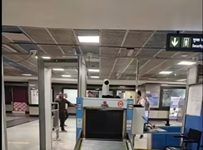An ongoing trial of a millimetre wave-based full-body scanner at Indira Gandhi International airport’s Terminal 2 has revealed that the detection rate is low. Airport sources said the scanner was unable to detect prohibited items concealed above the chin and 5cm below the ankle. Sources at Delhi airport said the preliminary trial report said the scanner was unable to detect folded scissors and 9mm magazine hidden in the zip area of trousers.
It also failed to detect blade packets, matchboxes, coins, Cordtex 2mm, sheet explosive, bracelets and anklets several times. Besides, it had to be calibrated manually every 30 seconds. Officials said trials will continue for a few more days and a report on the results will be submitted to the Bureau of Civil Aviation Security (BCAS).
Sources said, “During the trial run at Delhi, Mumbai and Bengaluru airports, body scanners were unable to detect prohibited items concealed in areas above the chin and 5cm below the ankle. Some small-sized prohibited items also went undetected.” However, in the past, authorities have nabbed passengers found carrying banned items that they had concealed in shoes, ears and hair.
Another senior official at Delhi airport said it was observed that the scanner was unable to detect prohibited items hidden in the front of a trouser’s belt area. Moreover, the scanner also gave a false alarm in case of sweat.
A full-body scanner is a device that detects objects without making physical contact or breaching the privacy of passengers, thus reducing the number of random pat-downs and strip searches. A full-body scanner can detect non-metal objects that are hard to detect with the door-frame metal detector.
The trial of the scanner, which was installed at T2, began on June 28 for a period of 45 to 60 days. “When the trial period is over, all stakeholders will submit their feedback to BCAC. After examining it, regulatory bodies will decide the next course of action and share a report with all stakeholders,” said another airport official.








